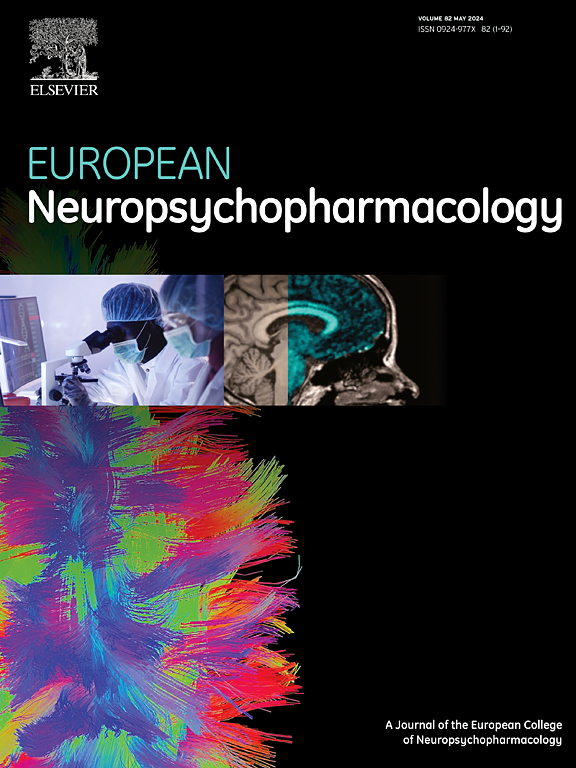焦虑症的遗传风险和大脑结构之间的联系
IF 6.7
2区 医学
Q1 CLINICAL NEUROLOGY
引用次数: 0
摘要
焦虑症与大脑不同区域的结构差异有关,包括皮层和皮层下形态以及白质完整性的改变。尽管来自神经影像学研究的证据越来越多,但这些神经特征在基因上与焦虑的联系程度仍未得到充分了解。阐明焦虑和大脑形态之间的共同遗传结构对于揭示导致这些疾病的脆弱性和表达的个体差异的生物学机制至关重要。在这项研究中,我们通过整合来自PGC-Anxiety (N = 122,341)的全基因组关联数据和来自UK Biobank的成像遗传数据,研究了焦虑和大脑结构之间的共享遗传结构。神经影像学数据包括196种来自结构MRI和扩散张量成像的整体和区域脑表型,涵盖皮质厚度、表面积、皮质下体积以及白质微观结构的测量,如分数各向异性和平均扩散率。为了量化共同遗传影响的程度,我们采用了几种互补的统计方法。使用连锁不平衡评分回归(LDSC)来估计焦虑与脑形态之间的全基因组遗传相关性。使用MiXeR来表征多基因重叠,估计共享和性状特异性变异的数量。此外,我们还进行了条件错误发现率(condFDR)分析,以确定与焦虑和大脑表型共同相关的基因组位点,通过利用多效性和混合效应方向来提高统计能力。所有的分析都是在全球和区域层面进行的,以确定与共享遗传结构最密切相关的大脑结构。我们的研究结果强调了焦虑和多种大脑表型之间的显著遗传相关性和重叠位点,为支持焦虑风险的生物学途径提供了新的见解。这些结果表明,特定大脑区域的结构变异可能反映了潜在的焦虑遗传易感性,并可能代表了连接遗传风险和临床表现的中间表型。本文章由计算机程序翻译,如有差异,请以英文原文为准。
CONNECTING GENETIC RISK AND BRAIN STRUCTURE IN ANXIETY DISORDERS
Anxiety disorders have been associated with structural differences in various brain regions, including alterations in cortical and subcortical morphology and white matter integrity. Despite growing evidence from neuroimaging studies, the degree to which these neural features are genetically linked to anxiety remains insufficiently understood. Elucidating the shared genetic architecture between anxiety and brain morphology is critical for uncovering the biological mechanisms that contribute to individual differences in vulnerability and expression of these conditions.
In this study, we investigated the shared genetic architecture between anxiety and brain structure by integrating genome-wide association data from PGC-Anxiety (N = 122,341) and imaging-genetic data from the UK Biobank. The neuroimaging data included 196 global and regional brain phenotypes derived from structural MRI and diffusion tensor imaging, covering cortical thickness, surface area, subcortical volumes, and measures of white matter microstructure such as fractional anisotropy and mean diffusivity.
To quantify the extent of shared genetic influences, we employed several complementary statistical approaches. Linkage disequilibrium score regression (LDSC) was used to estimate genome-wide genetic correlations between anxiety and brain morphology. MiXeR was applied to characterize the polygenic overlap, estimating the number of shared and trait-specific variants. Additionally, conditional false discovery rate (condFDR) analysis was conducted to identify genomic loci jointly associated with anxiety and brain phenotypes, increasing statistical power by leveraging pleiotropy and utilising mixed effect directions. All analyses were performed at both global and regional levels to identify brain structures most strongly implicated in the shared genetic architecture.
Our findings highlight significant genetic correlations and overlapping loci between anxiety and multiple brain phenotypes, providing novel insights into the biological pathways that underpin anxiety risk. These results suggest that structural variation in specific brain regions may reflect underlying genetic vulnerability to anxiety and could represent intermediate phenotypes that bridge genetic risk and clinical presentation.
求助全文
通过发布文献求助,成功后即可免费获取论文全文。
去求助
来源期刊

European Neuropsychopharmacology
医学-精神病学
CiteScore
10.30
自引率
5.40%
发文量
730
审稿时长
41 days
期刊介绍:
European Neuropsychopharmacology is the official publication of the European College of Neuropsychopharmacology (ECNP). In accordance with the mission of the College, the journal focuses on clinical and basic science contributions that advance our understanding of brain function and human behaviour and enable translation into improved treatments and enhanced public health impact in psychiatry. Recent years have been characterized by exciting advances in basic knowledge and available experimental techniques in neuroscience and genomics. However, clinical translation of these findings has not been as rapid. The journal aims to narrow this gap by promoting findings that are expected to have a major impact on both our understanding of the biological bases of mental disorders and the development and improvement of treatments, ideally paving the way for prevention and recovery.
 求助内容:
求助内容: 应助结果提醒方式:
应助结果提醒方式:


